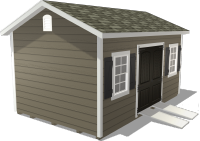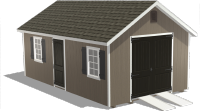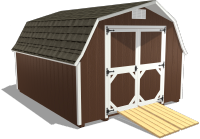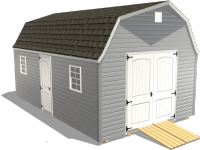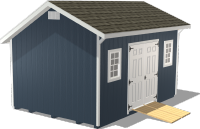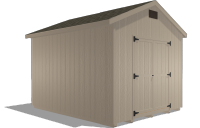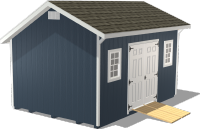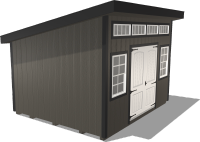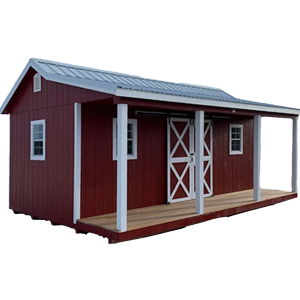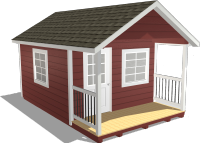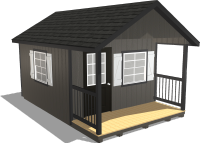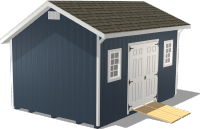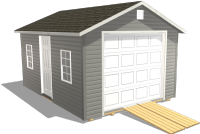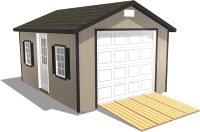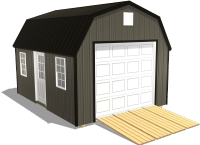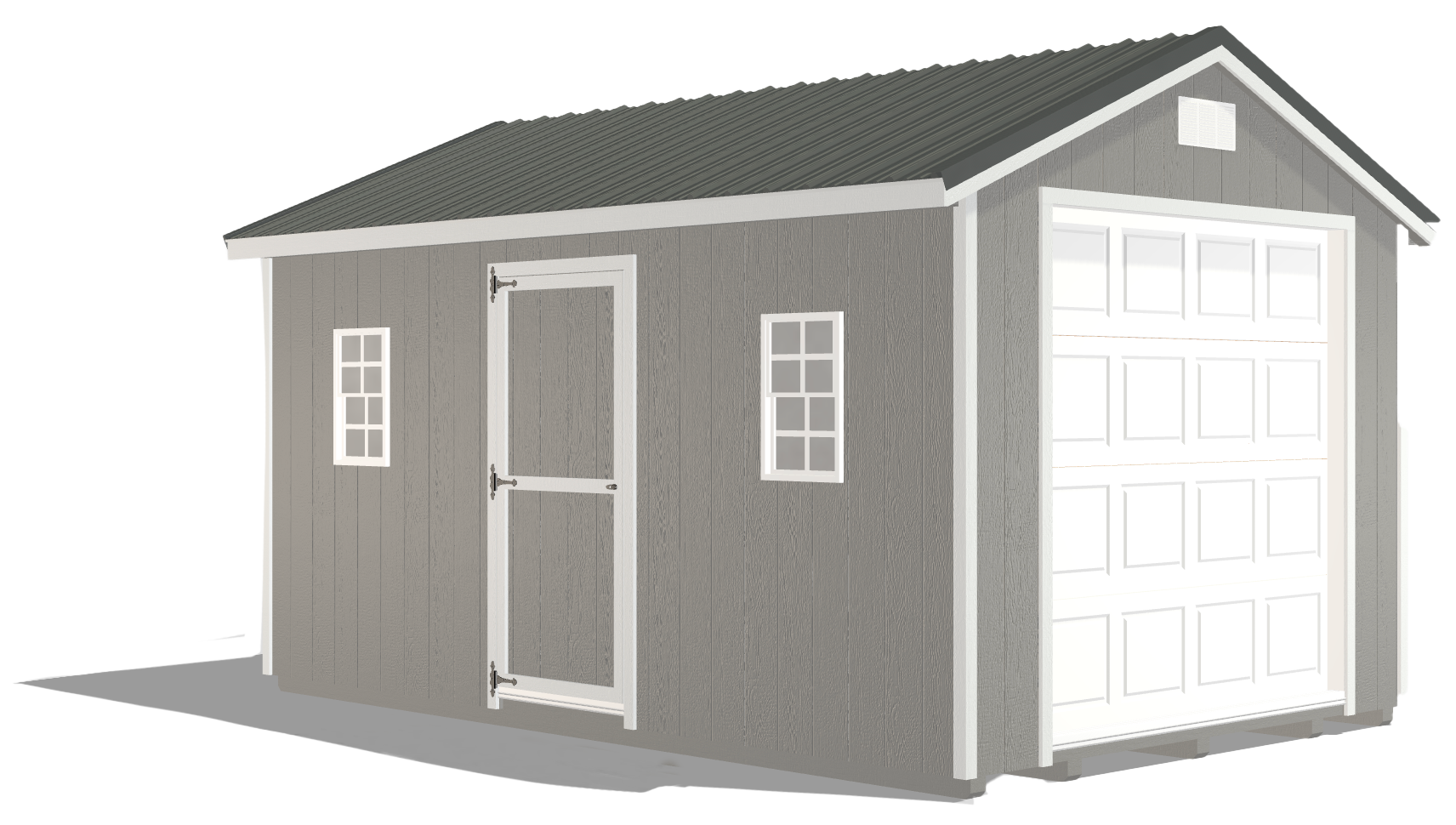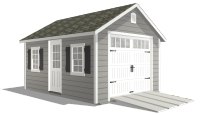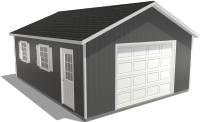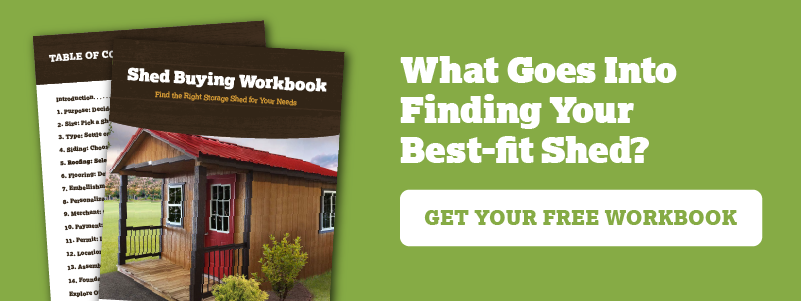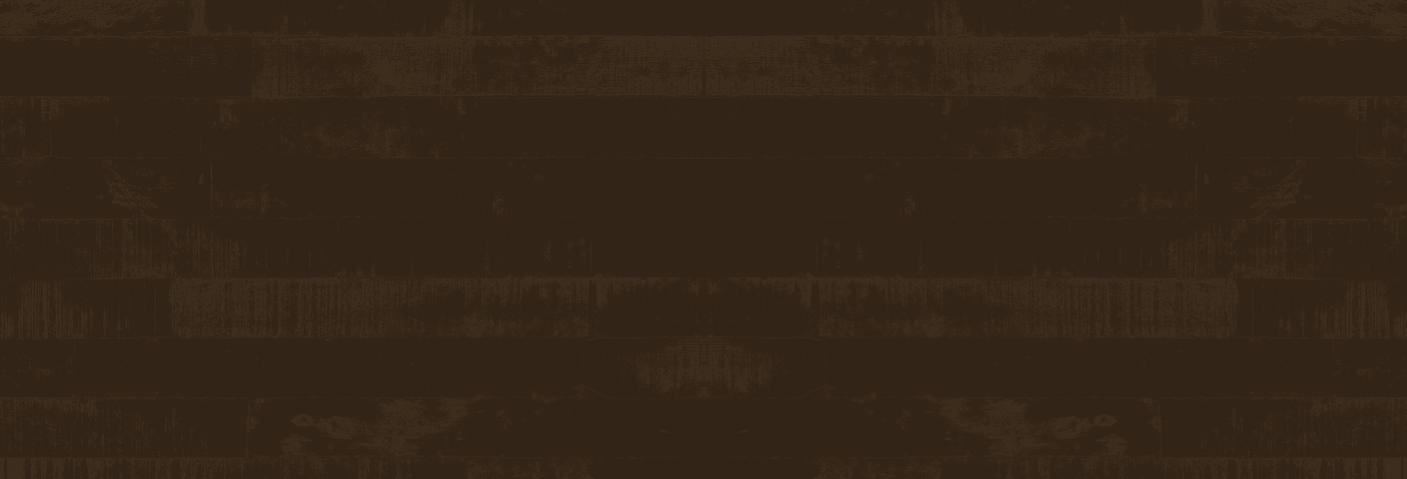Buying a Storage Shed? Here’s Your Ultimate Beginner’s Guide
by Dakota Storage Buildings, on May 19, 2025

Have you reached the point where clutter is taking over your home, but you're not quite ready to part with your belongings? Or maybe you’re dreaming of a quiet backyard workspace or a place to finally organize your lawn and garden tools.
Whatever your needs, a well-built outdoor storage shed can be the perfect solution. Sheds do more than just store stuff — they serve as home offices, hobby workshops, gardening stations, and even extra living space.
But if you’re a first-time shed buyer, the process can feel overwhelming. With so many sizes, materials, and features to choose from, it’s easy to end up with a backyard shed that doesn’t meet your needs or blow your budget.
We want to walk you through everything you need to consider before buying a storage shed — from how much does a shed cost, to understanding your shed’s purpose, to planning your space and avoiding common buying mistakes. Let’s get started.
Pinpointing Your Needs for the Perfect Shed Purchase
Before diving into styles, materials, or price points, it’s important to think about why you need a shed in the first place.
A shed can serve as a workshop, a garden prep station, a home office, or even a quiet place to unwind. The more clearly you define its purpose, the easier it will be to choose a design and size that works for you.
How to Identify Your Shed’s Purpose
Ask yourself:
- What will I be storing?
- Do I need a workspace, a hobby room, or just storage?
- Will this shed be used year-round?
- Do I plan to expand my storage needs in the future?
These questions can help determine the size and layout of your backyard shed, and the features you may want to prioritize, such as insulation, ventilation, or windows for natural light. Your answers determine what features, layout, and insulation you may need.
Size and Space Planning Guide
When it comes to sizing, don’t just think about what you need now — consider what you might need in the future.
Once you’ve nailed down the purpose, measure your available space. Don’t forget to account for door swing, landscaping, or walkways.
Here’s a quick guide to shed sizes by use:
- Small (8'x10' or smaller): Ideal for lawn tools, bikes, and seasonal storage.
- Medium (10'x12' to 12'x16'): Great for garden equipment, small workshops, or home gyms.
- Large (14'x20' or bigger): Suited for multi-purpose spaces, large equipment, or full-fledged backyard studios.
Buying a storage shed is a big step, and you’ll want to be fully informed of all your options. To help minimize some of the stress that comes with shed shopping, we are going to cover some of the most important aspects of a shed that you will need to look out for.
Price
While staying on budget is always a good thing, make sure you are not sacrificing quality. When you invest in high-quality materials, your shed will have a longer lifespan and increased durability. If you want to buy a backyard shed that will be in use for the long haul, investing in a well-built shed is a necessity.
If you have a tight budget, consider compromising on the bells and whistles. The added features are not always necessary and add extra costs that your budget may not be able to cover. This will free up some of your finances and invest in a simple shed with basic materials. A simple, well-built shed is much better than a cheaply made structure with fancy details.
Hidden Costs to Watch For
When factoring how much does a shed cost, first-time buyers are often surprised by additional costs that pop up along the way. For instance, delivery fees can vary depending on your location and how accessible your site is. Some companies offer free delivery within a certain radius, while others charge per mile.
Installation is another factor. Will your shed arrive fully assembled, or will it need to be built on-site? Site prep — like leveling the ground or laying a gravel or concrete foundation — is often the buyer’s responsibility
Then there’s maintenance. Wooden sheds, for example, may require regular painting or staining to prevent weather damage, while vinyl or metal sheds might offer a more maintenance-free experience. Knowing these upfront costs can help you plan your budget more accurately and avoid surprises.
Pro Tip: Don’t forget to check local zoning regulations. Some municipalities require permits for sheds over a certain size, which may involve a small fee or added paperwork.
Design
For many, adding a shed to their backyard not only provides valuable storage but also adds dimension to their yard. Design elements and landscaping can add color and life to your property. By coordinating the colors, style, and features with your home, you can create a yard that feels inviting. Adding small landscaping elements can help your shed blend into its surroundings.

Shed design trends offer something for every style:
- Farmhouse sheds have the clean lines of contemporary designs, the cozy aesthetic of a homestead, and enough room for indoor storage and workspace. Plus, it also has a covered front porch.
- Modern sheds typically feature sleek edges, a distinctive roofline, and attractive transom windows.
- Garden sheds have charming features, like shutters or flower boxes, to match the ambiance of your garden.
Custom Design Features to Consider
One of the biggest advantages of buying a storage shed today is the ability to customize it. You're not stuck with a one-size-fits-all design — you can make it truly your own. Think about how you’ll be using the shed and what details would make it more functional or enjoyable.
These customizable features can elevate both style and function:
- Skylights or transom windows bring in natural light, which is especially helpful if you plan to use the space as a workshop or potting shed.
- Double doors can make a world of difference when moving large equipment in and out.
- Built-in shelving or lofts can help you maximize vertical storage and keep your tools organized.
- Color contrast trim can enhance curb appeal and make your shed feel like a natural extension of your property.
Materials
Backyard sheds come in all different shapes and sizes, along with numerous material options. With siding alone, you have three options to choose from. They can last for quite a while and have a variety of colors to choose from.
- Metal Siding: Durable and low-maintenance, metal siding is ideal for withstanding harsh weather conditions.
- Vinyl Siding: A favorite for homeowners who want a shed that’s easy to maintain and visually matches their home.
- Wood Siding: For a classic, natural look, wood siding remains a go-to option. We recommend treated wood for extra durability.
When it comes to roofing, you want to ensure that the material is weatherproof and durable in any climate. The roof will come in contact with harsh conditions like hail, rain, snow, and ice and should be able to withstand any natural elements.
Just like your home, your shed’s roof needs to be able to keep your belongings secure and safe. Asphalt shingles and steel panels are some of the best roofing options available for outdoor sheds.
Zoning Laws
To ensure you do not encounter any hiccups, inquire with your local government to see if there are any restrictions on backyard sheds. Sometimes, sheds over 120 square feet require approval, and the shed’s placement can have limitations. By checking with the proper authorities before you buy a shed, you can make sure it does not violate any regulations.
Here's a simple step-by-step checklist to ensure you're fully informed and compliant:
✔️ Identify Your Local Building Authority: Start by finding out which local government office handles building codes and permits in your area. This could be your city hall, county clerk, or local building department.
✔️ Request Information on Shed Regulations: Contact the identified office and ask for information regarding regulations specific to sheds. Be sure to inquire about size limitations, placement restrictions, and any other pertinent rules.
✔️ Check for Permit Requirements: Ask if a permit is required for your intended shed size and style. Sheds over certain sizes often require a building permit.
✔️ Review Property Lines and Setbacks: Determine how close your shed can be to property lines, buildings, and other structures. This is crucial for planning the placement of your shed.
✔️ Gather Necessary Documentation: If a permit is required, find out what documentation you’ll need to provide. This may include site plans, shed specifications, and proof of property ownership.
✔️ Submit Your Permit Application: Complete any required forms and submit them along with your documentation and the applicable fee. Ensure all your paperwork is filled out correctly to avoid delays.
✔️ Wait for Approval: Once submitted, there will be a waiting period while your application is reviewed. Use this time to prepare your site, ensuring it’s ready for installation once your permit is approved.
✔️ Stay Informed About Changes: Regulations can change, so stay in touch with your local building authority to keep up to date with any new requirements or amendments.
Foundation

Regardless of your budget or style preferences, laying a foundation is essential to prevent corrosion. When your shed is elevated and equipped with a draining system, it will be ready to withstand any weather elements that may come its way.
Top Foundation Types for Sheds
A solid foundation is critical to your shed’s longevity and stability. The type of foundation you choose depends on your shed size, soil conditions, and how you plan to use the space.
- Gravel pads are one of the most popular options. They’re cost-effective, drain well, and provide a stable base for most sheds.
- Concrete slabs offer a more permanent solution and are ideal for larger sheds or those used year-round, especially if you're adding electricity.
No matter which foundation you choose, make sure the ground is level and well-prepared before installation. Poor prep can lead to moisture issues, warping, and even structural damage over time.
Is Flooring a Necessity?
Meanwhile, flooring is optional and based on your needs. While it is an extra cost, if you are going to be spending a large amount of time working or relaxing in the shed, the extra layer of comfort may be worth the investment.
If your intended purpose for the shed is to store tools, equipment, and other stuff, skip the flooring. In the future, if you decide that you would like your shed to have proper floors, you can add them later.
Cost
How much does a shed cost? While the price of an outdoor shed can vary drastically, we will give you a basic rundown of the different types of sheds and the investment cost.

On average, a pre-built shed can cost anywhere from $1,000 to $4,000. If you are looking for a large farm shed, it would be more than double that amount.
A custom shed will be the more expensive option but is unique to the buyer’s needs and style. It is difficult to accurately convey pricing for custom sheds due to each shed having specific characteristics.
A good rule of thumb is that a custom shed will typically range from $17 to $24 per square foot. With both pre-built and custom sheds, the price will vary depending on materials, size and style. It is important to do your research on pricing before you buy a shed.
Budget Planning Tips
When planning your shed budget, it’s easy to get carried away by add-ons and upgrades. That’s why it’s helpful to distinguish between “must-haves” and “nice-to-haves.” Start by identifying the essential features your shed needs to be functional. Then, layer on upgrades as your budget allows.
It’s also smart to think long-term. Spending a little more on quality materials today can save you money on repairs or replacements down the road. Look for backyard sheds that come with warranties, and ask about financing options.
If you’re working within a strict budget, semi-custom shed packages can offer a great middle ground — giving you the look and feel you want without the cost of a fully custom build.
Understanding Different Shed Types and Their Best Uses
Your outdoor storage shed’s purpose greatly affects which type of shed you should invest in. From a fishing cabin to a gardener's oasis to a nice guest house, sheds can be whatever you want!
Here are some of the most common types.

Standard Sheds
These types of sheds appeal to those mainly interested in a storage solution. From storing garden equipment to precious memorabilia, this option is ideal to keep excess stuff out of your home and garage.
A gardener who needs extra space, a handyman wanting a workshop, or a family with too many hand-me-downs, a standard shed would provide extra space for any of those needs.
Utility Sheds
If staying within budget is a top priority, consider a utility shed. These options maintain durability while being low-cost and budget-friendly.
These pre-built or custom outdoor storage shed solutions would be ideal for a family that is just looking for a basic, sturdy place to store extra stuff.
Specialty Sheds
Specialty sheds are each unique and serve a different purpose.
A modern backyard shed would be a valuable addition to any home that is looking for an upscale storage solution. A cabin shed can be used by the lake to store fishing and hunting equipment. Man caves and she-sheds can add a bonus relaxing space. Meanwhile, farmhouse sheds offer a cozy aesthetic with a covered front porch. Whatever you choose, you can customize it to suit your specific needs.
6 Steps for a Successful Shed Purchase
Ready to take the plunge? Here’s your simplified buying journey — complete with what to watch for at every step:
1. Define your needs and budget.
Start by thinking through what you’ll use the shed for. Is it primarily for tool storage? A backyard office? A gardening hub? Clarifying the purpose will guide all other decisions. Be honest about how much you’re willing to spend, and leave some room in your budget for add-ons or delivery costs.
2. Research shed types, sizes, and materials.
Once you know your goals, compare shed types — like prefab, custom, or semi-custom — and materials such as treated wood, vinyl, or metal. Each option has its own pros and cons in terms of appearance, maintenance, and longevity.
3. Get quotes and compare reputable suppliers.
Don’t just focus on price. Look for quality craftsmanship, positive customer reviews, and clear warranty information. Ask what’s included in the price — some quotes may not factor in delivery, installation, or site prep.
4. Check local zoning laws and permit requirements.
Before you order anything, contact your local municipality or HOA to make sure your chosen shed size and placement meet zoning requirements. Some areas have rules on height, distance from property lines, and exterior materials.
5. Choose a foundation that suits your property.
A strong foundation is critical for your shed’s longevity. Gravel pads are great for drainage, concrete slabs offer unbeatable durability, and pressure-treated wood bases can work well on uneven terrain.
6. Place your order and schedule delivery.
Once all your research is complete and you’ve chosen a backyard shed that fits your needs, place the order with confidence. Make sure the delivery timeline and installation expectations are clearly communicated, and prep your site ahead of time so everything goes smoothly.
Common Buying Mistakes to Avoid
.jpg?width=624&height=312&name=Blog_Blue%20Backyard%20Shed_900x450%20(1).jpg)
Even well-intentioned buyers can make these missteps. Here's how to steer clear of trouble:
Choosing the cheapest option without checking the material quality.
How much does a shed cost is an important factor. However, a bargain isn’t a deal if the materials warp, crack, or rot after a few seasons. Always ask about flooring, siding, and roofing materials before buying a storage shed.
Overlooking the warranty.
A strong warranty shows the company stands behind its product. Make sure you understand what’s covered—and for how long—before finalizing your purchase.
Neglecting proper site prep before delivery.
Even the best shed won’t last long on uneven or soggy ground. Clear the site, level the base, and install a suitable foundation to protect your investment.
Failing to plan for future storage needs.
Your shed should meet your needs now and a few years from now. If you’re on the fence between two sizes, go with the larger one—you’ll rarely regret having more space.
Why Buy from Dakota Storage Buildings?
If you want a backyard shed that’s built to last and backed by a team that puts customers first, Dakota Storage Buildings is a manufacturer you can trust. We understand that buying a storage shed isn’t just a transaction — it’s a long-term investment.
Our sheds are crafted with high-quality materials and designed to stand up to the elements, year after year. With options for full customization, you can get the style, size, and features that work best for your property and lifestyle.
From your first question to the final delivery, we’re here to make the process simple and stress-free. Need help choosing the right foundation? Want to explore design options through our 3D Configurator? Looking for financing that fits your budget? We’ve got you covered.
Ready to Enhance Your Outdoor Space?
Buying a storage shed doesn’t have to be complicated. With a little planning and the right guidance, you can find a shed that’s the perfect match for your needs, space, and budget.
Whether you’re looking for simple storage or a fully customized backyard workspace, the right shed can make your life more organized—and your property more functional.
Still not sure where to start? Download our free Shed Buying Workbook to walk through the process step-by-step and feel confident in your decision. When you're ready, our team is here to help you bring your vision to life.



